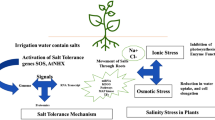Summary
Salinity is an environmental component that usually reduces yield. Recent advances in the understanding of salt effects on plants have not revealed a reliable physiological or biochemical marker that can be used to rapidly screen for salt tolerance. The necessity of measuring salt tolerance based upon growth in saline relative to non-saline environments makes salt tolerance measurements and selection for tolerance difficult. Additionally, high variability in soil salinity and environmental interactions makes it questionable whether breeding should be conducted for tolerance or for high yield. Genetic techniques can be used to identify the components of variation attributable to genotype and environment, and the extent of genetic variation in saline and nonsaline environments can be used to estimate the potential for improving salt tolerance. Absolute salt tolerance can be improved best by increasing both absolute yield and relative salt tolerance.
Similar content being viewed by others
References
Abel G H 1963 Inheritance of the capacity for chloride inclusion and chloride exclusion in soybeans. Crop Sci. 9, 697–698.
Akbar M and Yabuno T 1977 Breeding for saline-resistant varieties of rice. IV. Inheritance of delayed-type panicle sterility induced by salinity. Jap J. Breed. 27, 237–240.
Epstein E, Norlyn J D, Rush D W, Kingsbury R W, Kelly D B, Cunningham, G A and Wrona A W 1980 Saline culture of crops: a genetic approach. Science 210, 399–404.
Falconer D S 1952 The problem of environment and selection. Am. Nat. 86, 293–298.
Finlay K W and Wilkinson G N 1963 The analysis of adaptation in a plant breeding programme. Aust. J. Agric. Res. 14, 742–754.
Flowers T J, Troke P F and Yeo A R 1977 The mechanism of salt tolerance in halophytes. Annu. Rev. Plant Physiol. 28, 89–121.
Frey K J 1964 Adaptation reaction of oat strains selected under stress and non-stress environmental conditions. Crop Sci. 4, 55–58.
Greenway H and Munns R 1980 Mechanisms of salt tolerance in non-halophytes. Annu. Rev. Plant Physiol. 31, 149–190.
Johnson G R and Frey K J 1967 Heritabilities of the quantitative attributes of oats (Avena sp.) at varying levels of environmental stress. Crop Sci. 7, 43–46.
Maas E V 1985 Salt tolerance of plants.In Handbook of Plant Science in Agriculture. Ed. B R Christie, CRC Press Inc., Boca Raton, Florida (In press).
Maas E V and Hoffman G J 1977 Crop salt tolerance—current assessment. J. Irrig. Drainage Div., ASCE 103(IR2), 115–134.
Maas E V and Nieman R H 1978 Physiology of plant tolerance to salinity.In Crop Tolerance to Suboptimal Land Conditions. Ed. G A Jung. pp 277–299. Am. Soc. Agron. Spec. Publ. 32. Madison, WI.
Mederski H J and Jeffers D L 1973 Yield response of soybean varieties grown at two soil moisture stress levels. Agron. J. 65, 410–412.
Norlyn J D 1980 Breeding salt-tolerant crop plants.In Genetic Engineering of Osmoregulation—Impact on Plant Productivity for Food Chemicals and Energy. Basic Life Sciences. Vol 14. Eds. D W Rains, R C Valentine and A Hollaender. pp 293–309. Plenum Press, New York.
Pasternak D, Twersky M, and De Malach Y 1979 Salt resistance in agricultural crops.In Stress Physiology in Crop Plants. Eds. H W Mussell and R C Staples. pp 127–142. Wiley Interscience, New York.
Ream C L and Furr J D 1976 Salt tolerance of some Citrus species, relatives, and hybrids tested as rootstocks. J. Am. Soc. Hort. Sci. 101, 265–267.
Richards R A 1983 Should selection for yield in saline regions be made on saline or nonsaline soils? Euphytica 32, 431–438.
Rosielle A A and Hamblin J 1981 Theoretical aspects of selection for yield in stress and non-stress environments. Crop Sci. 21, 943–946.
Rush D W and Epstein E 1976 Genotypic responses to salinity. Differences between saltsensitive and salt-tolerant genotypes of tomato. Plant Physiol. 57, 162–166.
Rush D W and Epstein E 1981 Comparative studies on the sodium, potassium, and chloride relations of a wild halophytic and a domestic salt-sensitive tomato species. Plant Physiol. 68, 1308–1313.
Sacher R F, Staples R C and Robinson R W 1982 Salt tolerance in hybrids ofLycopersicon esculentum×Solanum pennellii and selected breeding lines.In Biosaline Research: A Look to the Future. Ed. A San Pietro, pp 325–336. Plenum Press, New York.
Sacher R F, Staples R C and Robinson R W 1983 Ion regulation and response of tomato to sodium chloride: a homeostatic system. J. Am. Soc. Hort. Sci. 108, 566–569.
Shannon M C 1978 Testing salt tolerance variability among tall wheatgrass lines. Agron. J. 70, 719–722.
Shannon M C 1982 Genetics of salt tolerance: new challenges.In Biosaline Research. A Look to the Future. Ed. A San Pietro, pp 271–282. Plenum Press, New York.
Shannon M C 1984 Breeding, selection and the genetics of salt tolerance.In Salinity Tolerance in Plants—Strategies for Crop Improvement. Eds. R C Staples and G H Toenniessen. pp 313–331. Wiley International, New York.
Shannon M C, McCreight and Draper J H 1983 Screening tests for salt tolerance in lettuce. J. Am. Soc. Hort. Sci. 108, 225–230.
Author information
Authors and Affiliations
Rights and permissions
About this article
Cite this article
Shannon, M.C. Principles and strategies in breeding for higher salt tolerance. Plant Soil 89, 227–241 (1985). https://doi.org/10.1007/BF02182244
Issue Date:
DOI: https://doi.org/10.1007/BF02182244




